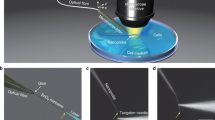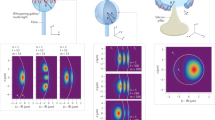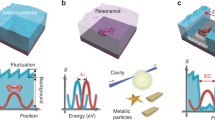Abstract
There is a strong demand for portable systems that can detect and characterize individual pathogens and other nanoscale objects without the use of labels, for applications in human health, homeland security, environmental monitoring and diagnostics1,2,3,4,5,6. However, most nanoscale objects of interest have low polarizabilities due to their small size and low refractive index contrast with the surrounding medium. This leads to weak light–matter interactions, and thus makes the label-free detection of single nanoparticles very difficult. Micro- and nano-photonic devices have emerged as highly sensitive platforms for such applications, because the combination of high quality factor Q and small mode volume V leads to significantly enhanced light–matter interactions7,8,9,10,11,12,13,14,15. For example, whispering gallery mode microresonators have been used to detect and characterize single influenza virions10 and polystyrene nanoparticles with a radius of 30 nm (ref. 12) by measuring in the transmission spectrum either the resonance shift10 or mode splitting12 induced by the nanoscale objects. Increasing Q leads to a narrower resonance linewidth, which makes it possible to resolve smaller changes in the transmission spectrum, and thus leads to improved performance. Here, we report a whispering gallery mode microlaser-based real-time and label-free detection method that can detect individual 15-nm-radius polystyrene nanoparticles, 10-nm gold nanoparticles and influenza A virions in air, and 30 nm polystyrene nanoparticles in water. Our approach relies on measuring changes in the beat note that is produced when an ultra-narrow emission line from a whispering gallery mode microlaser is split into two modes by a nanoscale object, and these two modes then interfere. The ultimate detection limit is set by the laser linewidth, which can be made much narrower than the resonance linewidth of any passive resonator16,17. This means that microlaser sensors have the potential to detect objects that are too small to be detected by passive resonator sensors18.
This is a preview of subscription content, access via your institution
Access options
Subscribe to this journal
Receive 12 print issues and online access
$259.00 per year
only $21.58 per issue
Buy this article
- Purchase on Springer Link
- Instant access to full article PDF
Prices may be subject to local taxes which are calculated during checkout





Similar content being viewed by others
References
Hoet, P. H., Bruske-Hohlfeld, I. & Salata, O. V. Nanoparticles – known and unknown health risks. J Nanobiotechnol. 2, 12 (2004).
Patolsky, F. et al. Electrical detection of single viruses. Proc. Natl Acad. Sci. USA 101, 14017–14022 (2004).
Naik, A. K. et al. Towards single-molecule nanomechanical mass spectrometry. Nature Nanotech. 4, 445–450 (2009).
Burg, T. P. et al. Weighing of biomolecules, single cells and single nanoparticles in fluid. Nature 446, 1066–1069 (2007).
Wang, S. P. et al. Label-free imaging, detection, and mass measurement of single viruses by surface plasmon resonance. Proc. Natl Acad. Sci. USA 107, 16028–16032 (2010).
Mitra, A. et al. Nano-optofluidic detection of single viruses and nanoparticles. ACS Nano 4, 1305–1312 (2010).
Armani, A. M. et al. Label-free, single-molecule detection with optical microcavities. Science 317, 783–787 (2007).
Arnold, S., Shopova, S. I. & Holler, S. Whispering gallery mode bio-sensor for label-free detection of single molecules: thermo-optic vs. reactive mechanism. Opt. Express 18, 281–287 (2010).
Vollmer, F. & Arnold, S. Whispering-gallery-mode biosensing: label-free detection down to single molecules. Nature Meth. 5, 591–596 (2008).
Vollmer, F., Arnold, S. & Keng, D. Single virus detection from the reactive shift of a whispering-gallery mode. Proc. Natl Acad. Sci. USA 105, 20701–20704 (2008).
Shopova, S. I., Rajmangal, R., Nishida, Y. & Arnold, S. Ultrasensitive nanoparticle detection using a portable whispering gallery mode biosensor driven by a periodically poled lithium-niobate frequency doubled distributed feedback laser. Rev. Sci. Instrum. 81, 103110 (2010).
Zhu, J. et al. On-chip single nanoparticle detection and sizing by mode splitting in an ultrahigh-Q microresonator. Nature Photon. 4, 46–49 (2010).
Li, H. et al. Analysis of single nanoparticle detection by using 3-dimensionally confined optofluidic ring resonators. Opt. Express 18, 25081–25088 (2010).
Mandal, S., Goddard, J. M. & Erickson, D. A multiplexed optofluidic biomolecular sensor for low mass detection. Lab. Chip 9, 2924–2932 (2009).
Ozdemir, S. K., Zhu, J., He, L. & Yang, L. Estimation of Purcell factor from mode-splitting spectra in an optical microcavity. Phys. Rev. A 83, 033817 (2011).
Yang, L. et al. A 4-Hz fundamental linewidth on-chip microlaser. CLEO2007, CMR2 (2007), available at http://www.opticsinfobase.org/abstract.cfm?uri=CLEO-2007-CMR2.
Schawlow, A. L. & Townes, C. H. Infrared and optical masers. Phys. Rev. 112, 1940–1949 (1958).
Yang, J. & Guo, L. J. Optical sensors based on active microcavities. IEEE J. Sel. Top. Quant. 12, 143–147 (2006).
Mazzei, A. et al. Controlled coupling of counterpropagating whispering-gallery modes by a single Rayleigh scatterer: a classical problem in a quantum optical light. Phys. Rev. Lett. 99, 173603 (2007).
Zhu, J., Ozdemir, S. K., He, L. & Yang, L. Controlled manipulation of mode splitting in an optical microcavity by two Rayleigh scatterers. Opt. Express 18, 23535–23543 (2010).
He, L., Ozdemir, S. K., Zhu, J. & Yang, L. Scatterer induced mode splitting in poly(dimethylsiloxane) coated microresonators. Appl. Phys. Lett. 96, 221101 (2010).
He, L., Ozdemir, S. K., Zhu, J. & Yang, L. Ultrasensitive detection of mode splitting in active optical microcavities. Phys. Rev. A 82, 053810 (2010).
Armani, D. K., Kippenberg, T. J., Spillane, S. M. & Vahala, K. J. Ultra-high-Q toroid microcavity on a chip. Nature 421, 925–928 (2003).
Yang, L. et al. Erbium-doped and Raman microlasers on a silicon chip fabricated by the sol-gel process. Appl. Phys. Lett. 86, 091114 (2005).
Ostby, E. P. & Vahala, K. J. Yb-doped glass microcavity laser operation in water. Opt. Lett. 34, 1153–1155 (2009).
Kim, W. et al. Demonstration of mode splitting in an optical microcavity in aqueous environment. Appl. Phys. Lett. 97, 071111 (2010).
Richter, L. E., Mandelberg, H. I., Kruger, M. S. & Mcgrath, P. A. Linewidth determination from self-heterodyne measurements with subcoherence delay times. IEEE J. Quantum Elect. 22, 2070–2074 (1986).
Person, S., Deutsch, B., Mitra, A. & Novotny, L. Material-specific detection and classification of single nanoparticles. Nano Lett. 11, 257–261 (2011).
Acknowledgements
The authors acknowledge support from the National Science Foundation (grant no. 0907467 and 0954941). This work was performed in part at the NRF/NNIN (NSF award no. ECS-0335765) of Washington University in St. Louis. We thank D. Chen for providing instrumentation for nanoparticle deposition, and F. Monifi and B. Peng for stimulating discussions.
Author information
Authors and Affiliations
Contributions
L.H., S.K.O., J.Z. and L.Y. designed the experimental concept. L.H. and J.Z. performed the experiments in air. L.H. and W.K. performed the experiments in water. L.H. and S.K.O. contributed to the theoretical work. L.Y. supervised the project. All authors contributed to the discussion of the results and the preparation of the manuscript.
Corresponding author
Ethics declarations
Competing interests
The authors declare no competing financial interests.
Supplementary information
Supplementary information
Supplementary information (PDF 2408 kb)
Rights and permissions
About this article
Cite this article
He, L., Özdemir, Ş., Zhu, J. et al. Detecting single viruses and nanoparticles using whispering gallery microlasers. Nature Nanotech 6, 428–432 (2011). https://doi.org/10.1038/nnano.2011.99
Received:
Accepted:
Published:
Issue Date:
DOI: https://doi.org/10.1038/nnano.2011.99
This article is cited by
-
A whispering-gallery scanning microprobe for Raman spectroscopy and imaging
Light: Science & Applications (2023)
-
Auxiliary-Cavity-Induced Ultrasensitive and Ultrahigh-Resolution Biomolecule Mass Sensing in a Hybrid Spinning Resonator System
Journal of Russian Laser Research (2023)
-
Detecting nanoparticles by “listening”
Frontiers of Physics (2023)
-
Optomechanical measurement of single nanodroplet evaporation with millisecond time-resolution
Nature Communications (2022)
-
Whispering-gallery-mode full-color laser textiles and their anticounterfeiting applications
NPG Asia Materials (2022)



